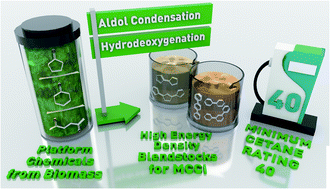The properties of bicyclic and multicyclic hydrocarbons as bio-derived compression ignition fuels that can be prepared via efficient and scalable routes from biomass†
Abstract
A series of multicyclic hydrocarbons were synthesized in high yield and under mild conditions from 2,5-hexanedione, cyclohexanone and cyclopentanone, on a scale of 200 g. Aldol products were obtained with conversions of 95% (2,5-hexanedione), 80–90% (cyclopentanone) and 75–80% (cyclohexanone), based on the consumption of starting materials. Cyclopentanone and cyclohexanone aldol condensations resulted in mixtures containing mainly bicyclic products (90%) as well as tricyclic analogs (<10%). The 2,5-hexanedione aldol condensation produced 50% methylcyclopentenone (MCP) as expected and about 50% oligomers. Surprisingly, the complex heavy fraction after the removal of MCP contained mainly the products of Michael addition of MCP and only a minor fraction of the self-aldol condensation product of MCP. The hydrogenation–hydrodeoxygenation (HDO) of cyclohexanone- and cyclopentanone-derived reactants with a nickel on alumina (Ni–Al2O3) catalyst at 250 °C and pressures between 800 and 1200 psig produced the expected saturated hydrocarbons with good recovery (80% and 76% respectively), with only small amounts of oxygenated residual starting materials remaining (<2%). However, the HDO of the 2,5-hexanedione aldol mixture produced an equally complex mixture compared to its respective aldol/Michael addition product which contained unreacted oxygenates. All crude mixtures, only treated to remove water after HDO unless stated otherwise, were evaluated for their properties as potential compression-ignition fuels: distillation curve, derived cetane number, sooting tendency, lower heating value, density, flash point and cold flow properties. The results show the utility of these hydrocarbons as viable compression-ignition fuels or blendstocks, particularly the cyclopentanone- or cyclohexanone-derived products.



 Please wait while we load your content...
Please wait while we load your content...